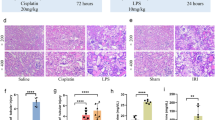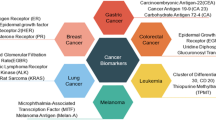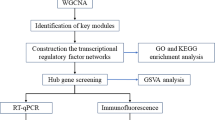Abstract
Acute myocardial infarction (AMI) is one of the most common cardiovascular emergencies, of which the molecular pathogenesis is still not fully understood. This study aimed to explore the differentially expressed genes (DEGs) and then identify the critical genes in AMI thus screening out potential biomarkers for the early diagnosis of this serious heart disease. The gene expression data of AMI patients (GSE19339) were downloaded from gene expression omnibus database. After preprocessing with affy package, the DEGs were screened out by significance analysis of microarray (SAM) algorithm within samr package. Then function and pathway enrichment analyses of the DEGs were carried out using DAVID (database for annotation visualization and integrated discovery software) online tools. Further, the relevant genes of AMI were screened out with GENETIC_ASSOCIATION_DB_DISEASE analysis and blastp alignment. Finally, the novel genes were subjected to transcription factor and protein–protein interaction network analyses. A total of 633 DEGs, including 378 up-regulated and 255 down-regulated, were screened out between AMI patients and normal control samples. Among those genes, several important ones such as PPAR, CCL2, HMOX1 and NPR1 were demonstrated to be related to AMI. Most importantly, a novel gene LCK (lymphocyte-specific protein tyrosine kinase) was significantly differentially expressed in AMI. Further analyses showed that LCK was involved in the expression regulation of CXCL12 (chemokine (C-X-C motif) ligand 12) and the expression of LCK can be regulated by different transcription factors. In this study, we provided a new insight into the mechanism of AMI and raised LCK as an attractive marker candidate in the diagnosis of this serious heart disease.




Similar content being viewed by others
References
Daubert MA, Jeremias A (2010) The utility of troponin measurement to detect myocardial infarction: review of the current findings. Vasc Health Risk Manag 6:691
Boersma E, Mercado N, Poldermans D, Gardien M, Vos J, Simoons ML (2003) Acute myocardial infarction. Lancet 361:847–858
He J, Gu D, Wu X et al (2005) Major causes of death among men and women in China. N Engl J Med 353:1124–1134
Sanderson JE, Mayosi B, Yusuf S, Reddy S, Hu S, Chen Z, Timmis A (2007) Global burden of cardiovascular disease. Heart 93:1175
Lloyd-Jones D, Adams R, Carnethon M et al (2009) Heart disease and stroke statistics—2009 update a report from the American Heart Association Statistics Committee and Stroke Statistics Subcommittee. Circulation 119:e21–e181
Caligiuri G, Nicoletti A (2006) Lymphocyte responses in acute coronary syndromes: lack of regulation spawns deviant behaviour. Eur Heart J 27:2485–2486
Recchioni R, Marcheselli F, Olivieri F, Ricci S, Procopio AD, Antonicelli R (2013) Conventional and novel diagnostic biomarkers of acute myocardial infarction: a promising role for circulating microRNAs. Biomarkers 18:547–558
Jaffe AS, Babuin L, Apple FS (2006) Biomarkers in acute cardiac diseasethe present and the future. J Am Coll Cardiol 48:1–11
Gerhardt W, Nordin G, Ljungdahl L (1999) Can Troponin T replace CK MBmass as “gold standard” for Acute Myocardial Infarction (“AMI”)? Scand J Clin Lab Inv 59:83–89
Morrow DA, Cannon CP, Jesse RL et al (2007) National Academy of Clinical Biochemistry Laboratory Medicine Practice Guidelines: clinical characteristics and utilization of biochemical markers in acute coronary syndromes. Clin Chem 53:552–574
Wang G-K, Zhu J-Q, Zhang J-T et al (2010) Circulating microRNA: a novel potential biomarker for early diagnosis of acute myocardial infarction in humans. Eur Heart J 31:659–666
Barrett T, Wilhite SE, Ledoux P et al (2013) NCBI GEO: archive for functional genomics data sets—update. Nucleic Acids Res 41:D991–D995
Gentleman RC, Carey VJ, Bates DM et al (2004) Bioconductor: open software development for computational biology and bioinformatics. Genome Biol 5:R80
Schwender H, Krause A, Ickstadt K (2006) Identifying interesting genes with siggenes. The Newsletter of the R Project Vol 6/5, December 2006 34:45
Dennis G Jr, Sherman BT, Hosack DA, Yang J, Gao W, Lane HC, Lempicki RA (2003) DAVID: database for annotation, visualization, and integrated discovery. Genome Biol 4:P3
Punta M, Coggill PC, Eberhardt RY et al (2012) The Pfam protein families database. Nucleic Acids Res 40:D290–D301
Frazer KA, Pachter L, Poliakov A, Rubin EM, Dubchak I (2004) VISTA: computational tools for comparative genomics. Nucleic Acids Res 32:W273–W279
Szklarczyk D, Franceschini A, Kuhn M et al (2011) The STRING database in 2011: functional interaction networks of proteins, globally integrated and scored. Nucleic Acids Res 39:D561–D568
Smoot ME, Ono K, Ruscheinski J, Wang PL, Ideker T (2011) Cytoscape 2.8: new features for data integration and network visualization. Bioinformatics 27:431–432
Bernardes A, Souza PC, Muniz JR et al (2013) Molecular mechanism of peroxisome proliferator-activated receptor α activation by WY14643: a new mode of ligand recognition and receptor stabilization. J Mol Biol 425:2878–2893
Braissant O, Foufelle F, Scotto C, Dauça M, Wahli W (1996) Differential expression of peroxisome proliferator-activated receptors (PPARs): tissue distribution of PPAR-alpha,-beta, and-gamma in the adult rat. Endocrinology 137:354–366
Doney A, Fischer B, Lee SP, Morris AD, Leese G, Palmer C (2005) Association of common variation in the PPARA gene with incident myocardial infarction in individuals with type 2 diabetes: a Go-DARTS study. Nucl Recept 3:4
Nikitin AG, Chistiakov DA, Minushkina LO, Zateyshchikov DA, Nosikov VV (2010) Association of the CYBA, PPARGC1A, PPARG3, and PPARD gene variants with coronary artery disease and metabolic risk factors of coronary atherosclerosis in a Russian population. Heart Vessels 25:229–236
Hamilton ST, Scott GM, Naing Z, Rawlinson WD (2013) Human cytomegalovirus directly modulates expression of chemokine CCL2 (MCP-1) during viral replication. J Gen Virol 94:2495–2503
Ikeda U, Matsui K, Murakami Y, Shimada K (2002) Monocyte chemoattractant protein-1 and coronary artery disease. Clin Cardiol 25:143–147
Boring L, Gosling J, Cleary M, Charo IF (1998) Decreased lesion formation in CCR2 −/− mice reveals a role for chemokines in the initiation of atherosclerosis. Nature 394:894–897
Gu L, Okada Y, Clinton SK, Gerard C, Sukhova GK, Libby P, Rollins BJ (1998) Absence of monocyte chemoattractant protein-1 reduces atherosclerosis in low density lipoprotein receptor–deficient mice. Mol Cell 2:275–281
Aiello RJ, PAK Bourassa, Lindsey S, Weng W, Natoli E, Rollins BJ, Milos PM (1999) Monocyte chemoattractant protein-1 accelerates atherosclerosis in apolipoprotein E-deficient mice. Arterioscler Thromb Vasc Biol 19:1518–1525
Devaux Y, Azuaje F, Vausort M, Yvorra C, Wagner DR (2010) Integrated protein network and microarray analysis to identify potential biomarkers after myocardial infarction. Funct Integr Genomics 10:329–337
Ishikawa K, Maruyama Y (2000) Heme oxygenase as an intrinsic defense system in vascular wall: implication against atherogenesis. J Atheroscler Thromb 8:63–70
Ono K, Goto Y, Takagi S, Baba S, Tago N, Nonogi H, Iwai N (2004) A promoter variant of the heme oxygenase-1 gene may reduce the incidence of ischemic heart disease in Japanese. Atherosclerosis 173:313–317
Richards AM, Nicholls MG, Espiner EA et al (2003) B-type natriuretic peptides and ejection fraction for prognosis after myocardial infarction. Circulation 107:2786–2792
Marth JD, Disteche C, Pravtcheva D, Ruddle F, Krebs EG, Perlmutter RM (1986) Localization of a lymphocyte-specific protein tyrosine kinase gene (lck) at a site of frequent chromosomal abnormalities in human lymphomas. Proc Natl Acad Sci USA 83:7400–7404
Ping P, Zhang J, Zheng Y-T et al (1999) Demonstration of selective protein kinase C–dependent activation of Src and Lck tyrosine kinases during ischemic preconditioning in conscious rabbits. Circ Res 85:542–550
Baines CP, Wang L, Cohen MV, Downey JM (1998) Protein tyrosine kinase is downstream of protein kinase C for ischemic preconditioning’s anti-infarct effect in the rabbit heart. J Mol Cell Cardiol 30:383–392
Ping P, Song C, Zhang J et al (2002) Formation of protein kinase Cε-Lck signaling modules confers cardioprotection. J Clin Invest 109:499–507
Wright DD, Sefton BM, Kamps MP (1994) Oncogenic activation of the Lck protein accompanies translocation of the LCK gene in the human HSB2 T-cell leukemia. Mol Cell Biol 14:2429–2437
Talab F, Allen JC, Thompson V, Lin K, Slupsky JR (2013) LCK is an important mediator of B-cell receptor signaling in chronic lymphocytic leukemia cells. Mol Cancer Res 11:541–554
Paterson JC, Tedoldi S, Craxton A et al (2006) The differential expression of LCK and BAFF-receptor and their role in apoptosis in human lymphomas. Haematologica 91:772–780
Rhee I, Veillette A (2012) Protein tyrosine phosphatases in lymphocyte activation and autoimmunity. Nat Immunol 13:439–447
Blum A, Yeganeh S (2003) The role of T-lymphocyte subpopulations in acute myocardial infarction. Eur J Intern Med 14:407–410
Bodi V, Sanchis J, Nunez J et al (2008) Uncontrolled immune response in acute myocardial infarction: unraveling the thread. Am Heart J 156:1065–1073
Inngjerdingen M, Torgersen KM, Maghazachi AA (2002) Lck is required for stromal cell–derived factor 1α (CXCL12)–induced lymphoid cell chemotaxis. Blood 99:4318–4325
Acknowledgments
This study was supported by National Natural Science Foundation of China (81270302), PUMC Youth Fund (2012-XHQN08), and Fuwai science &technology star project (2012-FWXX05).
Author information
Authors and Affiliations
Corresponding author
Additional information
Co-first authors: Fei Xu and Xiao Teng.
The Publisher and Editor retract this article in accordance with the recommendations of the Committee on Publication Ethics (COPE). After a thorough investigation we have strong reason to believe that the peer review process was compromised.
About this article
Cite this article
Xu, F., Teng, X., Yuan, X. et al. RETRACTED ARTICLE: LCK: a new biomarker candidate for the early diagnosis of acute myocardial infarction. Mol Biol Rep 41, 8047–8053 (2014). https://doi.org/10.1007/s11033-014-3702-8
Received:
Accepted:
Published:
Issue Date:
DOI: https://doi.org/10.1007/s11033-014-3702-8




